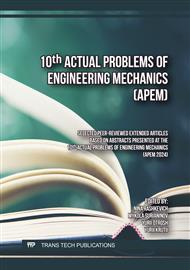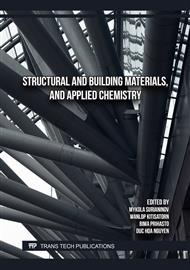[1]
H. Rüsch, Stahlbeton – Spannbeton, Band 1: Werkstoffeigenschaften und Bemessungsverfahren, Werner-Verlag, Düsseldorf, 1972.
Google Scholar
[2]
P. Bischoff and S. Perry, Compressive Behaviour of Concrete at High Strain Rates, Materials and Structures, 24(6) (1991) 425‒450.
DOI: 10.1007/bf02472016
Google Scholar
[3]
N. Han, Time Dependent Behaviour of High Strength Concrete, PhD Dissertation, Delft University of Technology, 1996.
Google Scholar
[4]
A. Ansell, A Literature review on the shear capacity of dynamically loaded concrete structures, Report 89, KTH Royal Institute of Technology, Concrete Structures, Stockholm, 2005.
Google Scholar
[5]
B. Riisgaard, T. Ngo, P. Mendis, C. Georgakis, & H. Stang, Dynamic Increase Factors for High Performance Concrete in Compression using Split Hopkinson Pressure Bar, Proceedings of the 6th International Conference on Fracture Mechanics of Concrete and Concrete Structures, 3 (2007) 1467‒1471.
DOI: 10.21012/fc10.235604
Google Scholar
[6]
X. Zhang, G. Ruiz, R.C. Yu, E. Poveda, R. Porras, Rate effect on the mechanical properties of eight types of high-strength concrete and comparison with FIB MC 2010, Construction and Building Materials, 30 (2012) 301‒308.
DOI: 10.1016/j.conbuildmat.2011.11.037
Google Scholar
[7]
DSTU B V.2.6-156: 2010, Konstruktsii budynkiv i sporud. Betonni ta zalizobetonni konstruktsii z vazhkoho betonu [Structures of buildings and structures. Concrete and reinforced concrete structures made of heavy concrete], Minrehionbud Ukrainy, Kyiv, 2011.
Google Scholar
[8]
A.S. Grigoriev, E.V. Shilko, V.A. Skripnyak, A.G. Chernyavsky, S.G. Psakhie, The numerical model of dynamic mechanical behavior of brittle materials based on the concept of the kinetic theory of strength, PNRPU Mechanics Bulletin, 3 (2017) 75‒99.
DOI: 10.15593/perm.mech/eng.2018.3.03
Google Scholar
[9]
CEB-FIP Model Code 1990, Design Code, Comité Euro-International du Béton, Lausanne, 1991.
DOI: 10.1680/ceb-fipmc1990.35430
Google Scholar
[10]
K. Fujikake, J. Mizuno, A. Suzuki, T. Ohno, T. Nonak, Dynamic strain softening of concrete in compression under rapid loading, WIT Transactions on the Built Environment: Structures under Shock & Impact, 32 (1998) 481‒491.
Google Scholar
[11]
Fib Model Code 2010, Final draft, Fib Bulletin, 66(2) (2012) 377.
Google Scholar
[12]
W.H. Dilger, R. Koch and R. Kowalczyk, Ductility of plain and confined concrete under different strain rates, ACI Journal, 81(1) (1984) 73‒81.
DOI: 10.14359/10649
Google Scholar
[13]
L.E. Malvern, D.A. Jenkins, T. Tang, C.A. Ross, Dynamic compressive testing of concrete, Proceedings of the Second Symposium on The Interaction of Non-Nuclear Munitions with Structures, (1985) 194‒199.
Google Scholar
[14]
J.W. Tedesco, C.A. Ross, Strain-rate-dependent constitutive equations for concrete, ASME J. Press. Vessel Technol, 120 (1998) 398‒405.
DOI: 10.1115/1.2842350
Google Scholar
[15]
D.L. Grote, S.W. Park, M. Zhou, Dynamic behavior of concrete at high strain-rates and pressures: I. Experimental characterization, International Journal of Impact Engineering, 25 (2001) 869‒886.
DOI: 10.1016/s0734-743x(01)00020-3
Google Scholar
[16]
K.S. Long, M. Kasmuri, A.S.Z. Hasan, R. Hamid, Dynamic Increase Factor of High Strength Concrete with Silica Fume at High Strain Rate Loading, Materials Science Forum, 857 (2016) 299‒304.
DOI: 10.4028/www.scientific.net/msf.857.299
Google Scholar
[17]
S. Lee, K.-M. Kim, J.-Y. Cho, Investigation into Pure Rate Effect on Dynamic Increase Factor for Concrete Compressive Strength, Procedia Engineering, 210 (2017) 11‒17.
DOI: 10.1016/j.proeng.2017.11.042
Google Scholar
[18]
B. Sun, R. Chen, Y. Ping, Z. Zhu, N. Wu, Z. Shi, Research on Dynamic Strength and Inertia Effect of Concrete Materials Based on Large-Diameter Split Hopkinson Pressure Bar Test, Materials, 15 (2022) 2995.
DOI: 10.3390/ma15092995
Google Scholar
[19]
O.V. Romashko-Maistruk, V.M. Romashko, Osnovni osoblyvosti deformuvannia betonu za dii dynamichnykh navantazhen [The main features of concrete deformation under the action of dynamic loads], Zb. nauk. prats UkrDUZT, 205 (2023) 60‒70.
DOI: 10.18664/1994-7852.205.2023.288924
Google Scholar
[20]
W.L. Cowell, Dynamic properties of plain Portland cement concrete, Technical Report No. R447. US Naval Civil Engineering Laboratory, Port Hueneme, California, 1966.
Google Scholar
[21]
S. Kono, F. Watanabe, A. Kajitani, Stress-strain relation of confined concrete under dynamic loading, In Fracture Mechanics of Concrete Structures, de Borst et al. (Ed.). Swets & Zeitlinger, Lisse, Netherlands, (2001) 585‒592.
Google Scholar
[22]
H. Othman, H. Marzouk, Strain Rate Sensitivity of Fiber-Reinforced Cementitious Composites, ACI Materials Journal, 113(2) (2016) 143‒150.
DOI: 10.14359/51688461
Google Scholar
[23]
M. Salman, A. Al-Amawee, The Ratio between Static and Dynamic Modulus of Elasticity in Normal and High Strength Concrete, Journal of Engineering and Development, 10(2) (2006) 163‒174.
Google Scholar
[24]
J. Popovics, A Study of Static and Dynamic Modulus of Elasticity of Concrete. Final Report, American Concrete Institute - Concrete Research Council, Urbana, IL., 2008.
Google Scholar
[25]
F.D. Lydon, R.V. Balendran, Some Observations on Elastic Properties of Plain Concrete, Cement and Concrete Research, 16(3) (1986) 314‒324.
DOI: 10.1016/0008-8846(86)90106-7
Google Scholar
[26]
X. Lu, Q. Sun, W. Feng, J. Tian, Evaluation of dynamic modulus of elasticity of concrete using impact-echo method, Construction and Building Materials, 47 (2013) 231‒239.
DOI: 10.1016/j.conbuildmat.2013.04.043
Google Scholar
[27]
S. Peng, Z. Yu, Q. Zhao, X. Du, X. Xie, B. Chen, Y. Zhang, Research on Dynamic Compressive Performance and Failure Mechanism Analysis of Concrete after High Temperature and Rapid Cooling, Materials, 15 (2022) 4642.
DOI: 10.3390/ma15134642
Google Scholar
[28]
O. Hjorth, Ein Beitrag zur Frage der Festigkeiten und des Verbundverhaltens von Stahl und Beton bei hohen Dehnungsgeschwindigkeiten, Dissertation TU Braunschweig, 1976.
Google Scholar
[29]
B.P. Hughes, A.J. Watson, Compressive strength and ultimate strain of concrete under impact loading, Mag. Concr. Res, 30(105) (1978) 189‒199.
DOI: 10.1680/macr.1978.30.105.189
Google Scholar
[30]
D. Watstein, Effect of straining rate on the compressive strength and elastic properties of concrete, ACI Journal, 49 (1953) 729‒744.
DOI: 10.14359/11850
Google Scholar
[31]
B. Bresler, V.V. Bertero, Influence of high strain rate and cyclic loading of unconfined and confined concrete in compression, Proceedings of 2nd Canadian Conference on Earthquake Engineering, Hamilton, Ontario, (1975) 1‒13.
Google Scholar
[32]
F.S. Rostasy, J. Scheuermann and K.H. Sprenger, Mechanical behaviour of some construction materials subjected to rapid loading and low temperature, Betonwerk+Fertigteil-Technik, 50(6) (1984) 393‒401.
Google Scholar
[33]
V.M. Romashko, General model and the mechanics of concrete elements and structures deformation, IOP Conf. Ser.: Materials Science and Engineering, 1021 (2021) 012026.
DOI: 10.1088/1757-899x/1021/1/012026
Google Scholar
[34]
V.M. Romashko, Deformatsiino-sylova model oporu betonu ta zalizobetonu [Deformation-force model of resistance of concrete and reinforced concrete], O.Zen, Rivne, 2016.
Google Scholar
[35]
V. Romashko, O. Romashko, Fundamentals of the General Theory of Resistance of Reinforced Concrete Elements and Structures to Power Influences, Materials Science Forum, 968 (2019) 534‒540.
DOI: 10.4028/www.scientific.net/msf.968.534
Google Scholar
[36]
V.M. Romashko and O.V. Romashko, Energy resource of reinforced concrete elements and structures for the deformation-force model of their deformation, IOP Conf. Ser.: Mater. Sci. Eng, 708 (2019) 012068.
DOI: 10.1088/1757-899x/708/1/012068
Google Scholar
[37]
V.M. Romashko, O.V. Romashko-Maistruk, Model ta metodyka rozrakhunku resursu zalizobetonnykh elementiv i konstruktsii [Model and method for calculating the resource of reinforced concrete elements and structures], Visnyk ODABA, 84 (2021) 59‒68.
DOI: 10.31650/2415-377x-2021-84-59-68
Google Scholar
[38]
V. Romashko, O. Romashko-Maistruk, Strength resource calculation of the reinforced concrete elements according to the energy criterion, Procedia Structural Integrity, 36 (2022) 269‒276.
DOI: 10.1016/j.prostr.2022.01.034
Google Scholar



